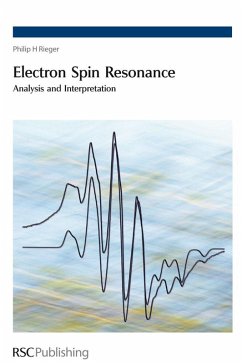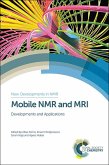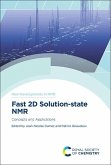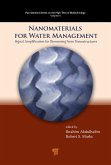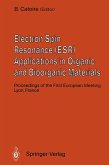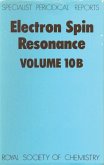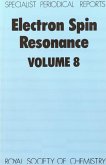

Alle Infos zum eBook verschenken

- Format: PDF
- Merkliste
- Auf die Merkliste
- Bewerten Bewerten
- Teilen
- Produkt teilen
- Produkterinnerung
- Produkterinnerung

Hier können Sie sich einloggen

Bitte loggen Sie sich zunächst in Ihr Kundenkonto ein oder registrieren Sie sich bei bücher.de, um das eBook-Abo tolino select nutzen zu können.
This book describes in mathematical terms the extraction of useful information from ESR spectra as applied to paramagnetic organic, inorganic and organometalic molecules. It lays a firm groundwork for understanding more sophisticated experiments, which the availability of newer commercial instruments has made possible. It takes the reader step by step through obtaining and interpretating ESR spectra of paramagnetic molecules. The mathematical basis of each observed phenomena are detailed and examples given. In particular there is a detailed discussion of 2nd order pertubation theory treatment of the Spin Hamiltonian for non-coincident G and A axes.…mehr
- Geräte: PC
- mit Kopierschutz
- eBook Hilfe
- Größe: 1.22MB
![Mobile NMR and MRI (eBook, PDF) Mobile NMR and MRI (eBook, PDF)]() Mobile NMR and MRI (eBook, PDF)175,95 €
Mobile NMR and MRI (eBook, PDF)175,95 €![Fast 2D Solution-state NMR (eBook, PDF) Fast 2D Solution-state NMR (eBook, PDF)]() Fast 2D Solution-state NMR (eBook, PDF)198,95 €
Fast 2D Solution-state NMR (eBook, PDF)198,95 €![Nanomaterials for Water Management (eBook, PDF) Nanomaterials for Water Management (eBook, PDF)]() Nanomaterials for Water Management (eBook, PDF)100,95 €
Nanomaterials for Water Management (eBook, PDF)100,95 €![Electron Spin Resonance (ESR) Applications in Organic and Bioorganic Materials (eBook, PDF) Electron Spin Resonance (ESR) Applications in Organic and Bioorganic Materials (eBook, PDF)]() Electron Spin Resonance (ESR) Applications in Organic and Bioorganic Materials (eBook, PDF)73,95 €
Electron Spin Resonance (ESR) Applications in Organic and Bioorganic Materials (eBook, PDF)73,95 €![Electron Spin Resonance (eBook, PDF) Electron Spin Resonance (eBook, PDF)]() Electron Spin Resonance (eBook, PDF)312,95 €
Electron Spin Resonance (eBook, PDF)312,95 €![Electron Spin Resonance (eBook, PDF) Electron Spin Resonance (eBook, PDF)]() Electron Spin Resonance (eBook, PDF)312,95 €
Electron Spin Resonance (eBook, PDF)312,95 €![Electron Spin Resonance (eBook, PDF) Electron Spin Resonance (eBook, PDF)]() Electron Spin Resonance (eBook, PDF)312,95 €
Electron Spin Resonance (eBook, PDF)312,95 €-
-
-
Dieser Download kann aus rechtlichen Gründen nur mit Rechnungsadresse in A, D ausgeliefert werden.
- Produktdetails
- Verlag: RSC
- Seitenzahl: 286
- Erscheinungstermin: 31. Oktober 2007
- Englisch
- ISBN-13: 9781847557872
- Artikelnr.: 44764169
- Verlag: RSC
- Seitenzahl: 286
- Erscheinungstermin: 31. Oktober 2007
- Englisch
- ISBN-13: 9781847557872
- Artikelnr.: 44764169
- Herstellerkennzeichnung Die Herstellerinformationen sind derzeit nicht verfügbar.
The ESR Experiment
Sensitivity
Saturation
Nuclear Hyperfine Interaction
Operation of an ESR Spectrometer
Optimization of Operating Parameters
Applications of ESR Spectroscopy
Electronic Structure Determination
Analytical Applications
Determination of Rates
References
Chapter 2: Isotropic ESR Spectra
Line Positions in Isotropic Spectra
Hyperfine Coupling Parameters
Second-order Splittings
Spin Hamiltonian Parameters from Spectra
Interpretation of Isotropic Parameters
Linewidths in Isotropic Spectra
Incomplete Averaging of Anisotropies
Rates of Fluxionality from Linewidths
Organic Radical Reactions
Analysis of Isotropic ESR Spectra
Preliminary Examination of the Spectrum
What do you expect to see?
Are the Gross Features of the Spectrum Consistent with the Model?
An Example
Detailed Analysis for Determination of Parameters
Computation of Multiplet Intensity Ratios
Multiplet Patterns Due to Isotopomers
Second-order Shifts in Line Positions
Related Techniques (ENDOR)
References
Chapter 3: Second-order Effects on Line Positions
Understanding the Variation in Line Widths
Puzzling Line Shapes
Use of ESR Spectra to Determine Formation Constants
References
Chapter 4: Introduction: Solid-State ESR Spectra
Spectra of Dilute Single Crystals
Analysis of Frozen Solution Spectra
Interpretation of the g-Matrix
Interpretation of the Hyperfine Matrix
Organometallic Examples
A Low-spin Manganese(II) Complex
Some Cobalt(0) Radical Anions
Organic Examples of Solid-State ESR Spectra
Irradiated Single Crystal Of Glycylglycine
X-irradiated Single Crystal of Methylene Diphosphonic Acid
Non-Coincident Matrix Axes
Symmetry Considerations
Experimental Determination of Matrix Axis Orientations
Organometallic Examples of Non-Coincident Matrix Axes
A Chromium Nitrosyl Complex
Iron Pentacarbonyl Ions
Another Low-Spin Manganese(II) Complex
Chromium(I) Piano-Stool Complex
[(RCCR')Co2(CO)6]- and [SFeCo2(CO)9]-
(o-xylylene)-Mn(dmpe)2
Cobalt Dithiolene Complexes
"g-Strain"
References
Chapter 5: Bloch's Phenomenological Model
Derivation of the Bloch Equations
Steady-State Solution
Chemical Exchange-The Modified Bloch Equations
Further Discussion of Line Shapes
Applications of the Modified Bloch Equations
Alternating Linewidth Effects
Spin Labels
References
Chapter 6: Biradicals
Exchange Coupling
Organic Triplet-State Molecules and the Dipolar Interaction
Organic Triplet-State Molecules
Transition Metal Complexes with S>1/2
Spin-Orbit Coupling
High-Spin Transition Metal Ions
Examples: K3Cr(CN)6 and K4V(CN)6
References
Chapter 7
Second-order Perturbation Theory Treatment of Spin Hamiltonian with
Non-Coincident g- and A-Axes
The Electron Zeeman Term
Nuclear Hyperfine Interaction
Perturbation Theory Treatment of Hyperfine Term
Example of Application of These Results
Quadrupole Coupling
Perturbation Theory Treatment of Quadrupole Term
Example of Application of Analysis of Quadrupole Effects
References
The ESR Experiment
Sensitivity
Saturation
Nuclear Hyperfine Interaction
Operation of an ESR Spectrometer
Optimization of Operating Parameters
Applications of ESR Spectroscopy
Electronic Structure Determination
Analytical Applications
Determination of Rates
References
Chapter 2: Isotropic ESR Spectra
Line Positions in Isotropic Spectra
Hyperfine Coupling Parameters
Second-order Splittings
Spin Hamiltonian Parameters from Spectra
Interpretation of Isotropic Parameters
Linewidths in Isotropic Spectra
Incomplete Averaging of Anisotropies
Rates of Fluxionality from Linewidths
Organic Radical Reactions
Analysis of Isotropic ESR Spectra
Preliminary Examination of the Spectrum
What do you expect to see?
Are the Gross Features of the Spectrum Consistent with the Model?
An Example
Detailed Analysis for Determination of Parameters
Computation of Multiplet Intensity Ratios
Multiplet Patterns Due to Isotopomers
Second-order Shifts in Line Positions
Related Techniques (ENDOR)
References
Chapter 3: Second-order Effects on Line Positions
Understanding the Variation in Line Widths
Puzzling Line Shapes
Use of ESR Spectra to Determine Formation Constants
References
Chapter 4: Introduction: Solid-State ESR Spectra
Spectra of Dilute Single Crystals
Analysis of Frozen Solution Spectra
Interpretation of the g-Matrix
Interpretation of the Hyperfine Matrix
Organometallic Examples
A Low-spin Manganese(II) Complex
Some Cobalt(0) Radical Anions
Organic Examples of Solid-State ESR Spectra
Irradiated Single Crystal Of Glycylglycine
X-irradiated Single Crystal of Methylene Diphosphonic Acid
Non-Coincident Matrix Axes
Symmetry Considerations
Experimental Determination of Matrix Axis Orientations
Organometallic Examples of Non-Coincident Matrix Axes
A Chromium Nitrosyl Complex
Iron Pentacarbonyl Ions
Another Low-Spin Manganese(II) Complex
Chromium(I) Piano-Stool Complex
[(RCCR')Co2(CO)6]- and [SFeCo2(CO)9]-
(o-xylylene)-Mn(dmpe)2
Cobalt Dithiolene Complexes
"g-Strain"
References
Chapter 5: Bloch's Phenomenological Model
Derivation of the Bloch Equations
Steady-State Solution
Chemical Exchange-The Modified Bloch Equations
Further Discussion of Line Shapes
Applications of the Modified Bloch Equations
Alternating Linewidth Effects
Spin Labels
References
Chapter 6: Biradicals
Exchange Coupling
Organic Triplet-State Molecules and the Dipolar Interaction
Organic Triplet-State Molecules
Transition Metal Complexes with S>1/2
Spin-Orbit Coupling
High-Spin Transition Metal Ions
Examples: K3Cr(CN)6 and K4V(CN)6
References
Chapter 7
Second-order Perturbation Theory Treatment of Spin Hamiltonian with
Non-Coincident g- and A-Axes
The Electron Zeeman Term
Nuclear Hyperfine Interaction
Perturbation Theory Treatment of Hyperfine Term
Example of Application of These Results
Quadrupole Coupling
Perturbation Theory Treatment of Quadrupole Term
Example of Application of Analysis of Quadrupole Effects
References
